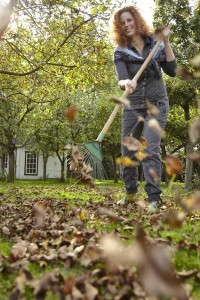Especially the fallen leaves in autumn protect the plants and many small living creatures from ice and cold in winter. If a blanket of snow comes over it, flora and fauna have it reasonably warm and cozy and all survive the winter period. Of course, the pests in the garden also survive. Here you only have to dispose of visibly infected leaves with fungal spores and snail eggs when the fallen leaves are collected. This then disappears in the residual waste, not on the compost.

Another thing: a garden also includes a few pests, because otherwise the birds have nothing to eat, the beneficial insects are also unemployed and starve. In a garden with good balance, all find their place and also have their right. A little of the fallen leaves is also transformed as humus. It improves the quality of the soil and makes plants grow better.
Contents
Recycle old fallen leaves on the compost
However, much of the old foliage is often swept from the beds toward the end of winter, starting in mid/late February, so that the spring bloomers can really grow out of the ground. The old fallen leaves then go into the compost, where they can continue to form into humus. If all the fallen leaves are disposed of with the residual waste, many microorganisms are also disposed of. These then end up in the waste incineration plant.
Using leaves as mulch
Leaves can also be used as mulch. To do this, it should rest for about two weeks. Then simply spread the leaf mulch on the ground. It is especially suitable for hedges, ornamental and berry bushes. In the case of oak, walnut or chestnut leaves, it should be noted that they are very coarse, decompose more slowly and should therefore be chopped. The leaves of these tree species contain many tannins. Therefore, only plants that need an acidic soil, such as azaleas, rhododendrons or blueberries, should be mulched with them.
So: fallen leaves may and should be left on the beds in winter for protection. From the end of February (depending on the region), the beds can be carefully swept free.
Rake off leaves from the lawn
One more thing: Hydrangeas, roses and many other small woody plants need a warm pack of fallen leaves for winter protection! Of course, you can also use straw, jute fabric, fir brushwood as protection. Old fallen leaves belong on the compost. Only the lawn must be freed from leaves from the beginning, otherwise the leaves will rot and the lawn will get stains or fungal diseases.
Whether you should dispose of fallen leaves or leave them lying around depends on various factors, including your aesthetic preferences, the health of your lawn and garden, and the local regulations in your area. Here are some considerations for both options:
Leaving Fallen Leaves:
- Natural Mulch: Allowing fallen leaves to remain on the ground can serve as natural mulch. The leaves help retain moisture, suppress weeds, and improve soil quality as they decompose.
- Wildlife and Beneficial Insects: Leaf litter provides habitat and food sources for various beneficial insects and small wildlife, contributing to a healthier ecosystem.
- Sustainability: Leaving leaves in place is an eco-friendly practice that reduces the need for bagging, hauling, and disposing of organic material.
- Time and Effort: It’s less labor-intensive than raking and bagging leaves, making it a more convenient option.
Disposing of Fallen Leaves:
- Lawn Health: Thick layers of leaves can smother and damage grass, leading to poor lawn health. If you have an abundance of leaves, especially from large trees, you may need to remove some to prevent these issues.
- Aesthetics: A yard covered in leaves may not be visually appealing to some homeowners, especially in urban or suburban settings.
- Pest and Disease Concerns: Excess leaf litter can create hiding places for pests like rodents and insects. It can also harbor diseases that may infect your plants in the spring.
- Local Regulations: Some municipalities have ordinances or regulations that require homeowners to remove leaves from their properties, as leaving them can be seen as a nuisance.
In summary, there is no one-size-fits-all answer. If you have a few leaves and your lawn and garden can benefit from the natural mulch and ecological advantages of leaving them in place, it may be a good option. However, if you have a large volume of leaves that could harm your lawn, create unsightly conditions, or lead to pest and disease problems, you may need to dispose of them. Ultimately, the choice should be based on your specific circumstances and preferences, as well as any local regulations that apply to leaf removal.









